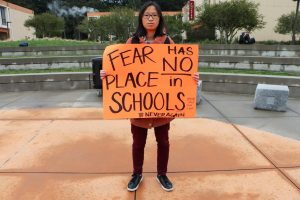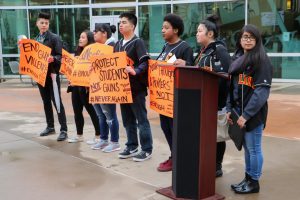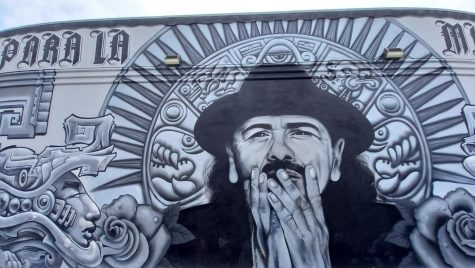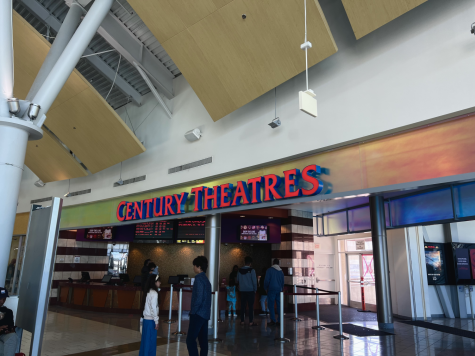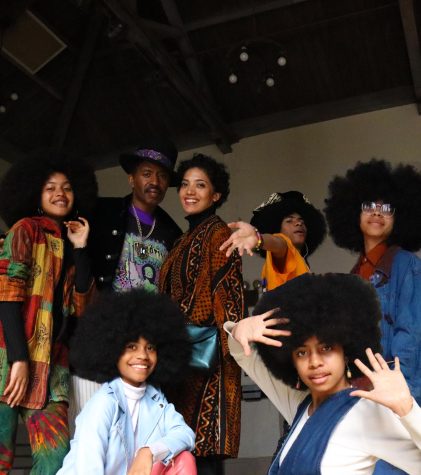Students walk out for change
Walkouts are a constant reminder that a unified student voice is a driver of change. During the last 50 years in each decade, students have started movements by expressing their collective opinion and advocating for a change. Community colleges play a large role in the student population and therefore have a significant opportunity to make an impact.
According to the American Association of Community Colleges, there are over 13 million community college students enrolled in campuses across the United States. This large amount of people exemplifies the potential for influence through the power in numbers and increases the social responsibility for community college students.
Walkouts throughout history have led to many advancements by tackling controversial issues such as segregation in the civil rights era and the Vietnam War draft. More recently, the walkouts have been in support of immigrants and opposing the termination of the Deferred Action for Childhood Arrivals program. The urgency of finding a solution to these problems is emphasized by students and their ability to assemble. Their organization sends a loud message of resolution to the nation.
Students promoting change can have reverberating effects seen far beyond campus walls.
In October 1963, 250,000 students walked out of Chicago schools demanding equitable educational resources for black children; in 1964, 450,000 black and Puerto Rican students in New York protested segregation in public schools a decade after the Supreme Court ruled it unlawful; in 1968, 15,000 Chicano students in East Los Angeles walked out against unequal conditions in their school district.
These student movements are examples of when an underrepresented population takes matters into their own hands and demands a change through action. The East LA student walkouts inspired the Chicano community to fight for their civil rights and use their strength in numbers to achieve the equality and representation they desired.
In the United States, today, there are still immense amounts of inequality in the education system, but that does not mean that students’ actions were unsuccessful. These past walkouts set the stage for a number of student-led movements and even though some of these walkouts were 50 years ago, the culture of students standing up for justice and what is right lives on today.
Gun control is the issue students are currently tackling, and guns have failed to be the center of focus on preventing these mass shootings. Students are realigning that focus and pressuring companies and legislators alike to make a necessary change.
Student action after the Parkland, Florida mass shooting caused an immediate response by large gun retailers like Dick’s Sporting Goods who stopped selling assault rifles and Walmart who raised the age to purchase an assault rifle from 18 to 21.
According to The New York Times, school campuses have turned into active shooter crime scenes 239 times since 2012 claiming 138 lives.
The direct effects gun violence has on the student population is responsible for students’ act of civil disobedience. Many campuses have the support of students and faculty alike. Here at Skyline, it is no different.
“I participated in this walk out because I feel like it’s such an important message to share with the nation that our youth matters that our youth’s safety matters,” said Nathaniel Navado counselor at Skyline College.
It is essential to the progress of student-led movements to have not only students from multiple ages to participate, but also for professors and administrators to get involved. Skyline’s community is a great example of how support from the administration can strengthen the students’ message.
“I feel honored and proud to be supporting a student leadership team that stands up and shows out and shows us what it means to be vocal and exercising our right to support community members across this country,” said Angélica Garcia, vice president of student services at Skyline College.
The Associated Students of Skyline College is instrumental in organizing walkouts and has the support of students and staff in their efforts. They effectively amplify the collective view of the student body through their ability to organize and assemble the entire campus community for a meaningful cause.
“As a member of the Associated Students of Skyline College, it’s our job to run programming and events on campus,” ASSC Senator Ameera Tullock said. “It was very important to me and to the rest of my fellow senators that we organized something in support of the students that died in Parkland.”
The responsibilities of students go far beyond the walls of campus; most students have any number of priorities that take precedence over getting involved in student movements such as going to work, taking care of a loved one, or raising a child. However, this did not prevent a large number of students from coming out in support of student lives.
Skyline students walked out of class on March 14. There were 17 minutes of silence in remembrance of the 17 victims of the Parkland, Florida mass shooting that took place at Marjory Stoneman Douglas High School. Skyline President Dr. Regina Stanback Stroud expressed her solidarity and shared inspiration with the students.
Skyline students filled the seating area in the quad as students and staff addressed the walkout participants. Many students expressed to The Skyline View why they walked out.
“I am walking out because I am for stricter gun control,” said Michael Kepler, a Skyline student.
“I walked out today because it’s an important issue. It’s something that has been overlooked for a long time and I think it definitely is going to make an impact,” said Cindy Suarez, a Skyline student participating in the March 14 walkout. “Even if Skyline is a smaller school and it’s raining, there is still students coming out, every person that’s here … it matters and it counts.”
Some people misinterpret students and school faculty working together to promote change as students being influenced by professors and teachers; this is far from what is occurring on campuses. College professors and administrators across the state wholeheartedly support their students’ call to action, and are proud to follow the youths’ lead.
The power and influence of the big gun corporations and associations are the main reason for our legislators’ inaction in preventing mass murder weapons from entering the wrong hands. But the impact of an educational community standing in unison, composed of students, staff and administration may be the catalyst that is needed to get tougher gun regulation on the Senate floor.
The student population represents a portion of the country that is willing to make a small sacrifice to shed light on a greater issue. In a turbulent time for the government and foreign affairs, it is easy to lose sight of domestic problems that are in dire need of immediate action and solutions. Gun violence is only one of many fronts that students will impact in the coming years.
Kelly Hensley, an English teacher at Mills high school and adviser to their campus newspaper The Thunderbolt, weighed in on students’ use of their education to bring about a positive change for the future.
“I want the students to have a voice and use their education to be productive citizens to shape our local, state, and national policies to reflect their concerns. If we disregard their voice, we disenfranchise our next generation, and that weakens our democracy. Allowing them to organize and express their voices empowers them to make changes that reflect their views and bring hope that our society can be a safer and better place.”





